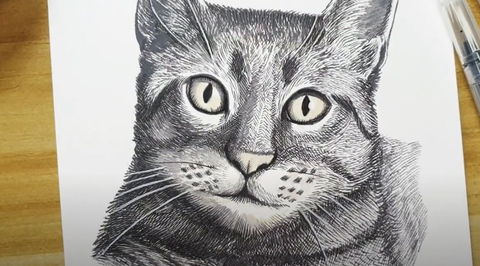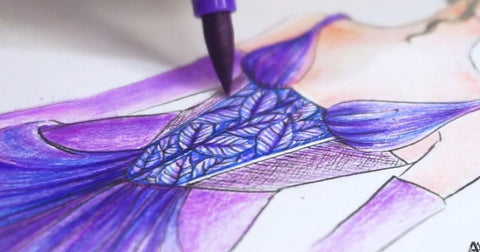How to Use Chiaroscuro to Add Depth to Your Artwork
Last Updated: October 13, 2025
"Our mind is the canvas on which the artists lay their color. Their pigments are our emotions; their chiaroscuro; the light of joy, the shadow of sadness. The masterpiece is of ourselves, as we are of the masterpiece." - Okakura Kakuzo
Have you ever heard of chiaroscuro? If you've ever admired famous paintings such as Ivan the Terrible and His Son Ivan, Girl with a Pearl Earring, and Saint Jerome Writing, you have seen chiaroscuro art at its finest.
Chiaroscuro is a technique that uses light and dark to create a strong contrast, allowing you to add richness and depth to your paintings. Chiaroscuro is a combination of two Italian words - "chiaro," meaning "clear" or "bright," and "scuro," meaning "obscure" or "dark," it encapsulates the idea of the interplay between light and shadow. The power of this technique cannot be understated. By playing with the balance between lightness and darkness, you can take your artwork from flat and dull to dynamic, capturing an emotion or absorbing the viewer into your world.

Woodless Coloring Pencils
In this blog post, we'll discuss how you can use chiaroscuro effectively to bring life to any painting. So come along and explore what delights await your chiaroscuro art when light and shadow take center stage!
What Is Chiaroscuro in Art?
Before we can fully understand chiaroscuro art, let's talk a walk through its history and the use of this art technique. The chiaroscuro technique originated in Greece in the 5th century but only became well-known in Rome during the 15th and 16th centuries. Chiaroscuro was initially called "skiagraphia" or shadow drawing, coined by a Greek artist named Apollodorus Skiagraphos. Although none of his artworks survived, to this day, his techniques in portraying shadow helped pave the way for chiaroscuro to become a well-known technique used by many artists.
It was only during the Renaissance Era that chiaroscuro really picked up, thanks to pioneer artists who improved this shading technique. Leonardo da Vinci started using chiaroscuro to achieve dimension by using light and dark tones in his portraits. He used brown-tinted paper, chalk, and white gouache to add highlights and shadows to his drawings, mimicking the effects of soft light hitting subjects at different angles.
Apart from being used in oil and tempera paintings, chiaroscuro was also used for watercolor painting, monochrome and two-tone ink drawings, and wood artwork during that time.
As the Baroque Era started, the effects of the chiaroscuro technique became bolder and more dramatic as artists used tenebrism alongside it, which entailed spotlighting a subject by using darker tones around them. Michelangelo Merisi da Caravaggio employed this by painting dark backgrounds and illuminating foreground subjects by gradually layering and blending tones of oil paint.
A Guide to Chiaroscuro Lighting in Your Own Artwork
Light is the catalyst for all that is beautiful in chiaroscuro art. The angle, intensity, and color of your light source can transform the mood of your artwork and evoke powerful emotions. There are many ways to use the effects of chiaroscuro - from creating fierce drama to producing a serene and peaceful scene. If you want inspiration on how to use chiaroscuro lighting to enhance your artwork, here are a few tips to get you started:

Monochrome Shading Pencils
Determine Your Light Source
You need to determine what type of light source you want your artwork to have first. A warm and soft light source, such as the gentle glow of a candle, can create a sense of intimacy and nostalgia. A harsh, bright light source, like the midday sun, can cast sharp shadows and highlights, creating a dramatic and intense effect.
On the other hand, a cool and moody light source, such as the silvery moonlight, can set a sad and melancholic tone. As an artist, you have the power to manipulate these light sources and use them to your advantage. Experiment with different lighting situations and watch as your artwork comes to life with depth and dimension!
Practice With the Materials You Want to Use
If this is your first time trying out chiaroscuro in painting, you must learn the different properties of the medium you want to use. Per medium, its application is different, and you will get varied results. Whether you use chalk, oil paint, watercolor, charcoal, or pencils, you need to master creating chiaroscuro effects by practicing over and over again. After all, creativity is a muscle, and you have to work out to achieve your wanted outcomes - a chiaroscuro art masterpiece.

Choose Your Subject to Work On
Chiaroscuro paintings mostly use the play of light and shadows to bring emphasis on a single aspect or subject. When you want to make your first chiaroscuro art, figure out what subject you want to paint and map out their positions on your artwork. Is it a still life? A portrait of a woman? A dramatic scene between lovers? Once you have figured out the characters of your painting or drawing, it's time to sketch them and determine the place of your light source. This will help guide you on what areas should be lighter and what areas should be darker.

Master Shading by Learning Your Subjects’ Light Angles
Shading is one of the key components of creating depth in your artwork with chiaroscuro. However, to make your artwork truly shine, it's crucial to understand how to shade different materials. Whether you're depicting a fruit, a scene, or a person, you must learn how to mimic how the light hits parts of your material. It also helps if you have a deeper understanding of the anatomy and build of your subject.

For example, human skin, the most complex material to shade, requires an understanding of the underlying structures like bones and muscles. If you want to create realistic effects, you need to pay attention to the shadows that are cast by your light source and how the skin itself responds to the light. Practice makes perfect, so be patient and keep experimenting! Just remember that the key to a successful chiaroscuro artwork is to capture the unique essence of each material and bring it to life through your shading techniques.
Ready to Unleash Your Inner Artist With These Tips?
Are you all set to become the next Da Vinci? Chiaroscuro has been used throughout art history to draw attention to certain points in a painting and create depth. While it can be a complex technique to master, the rewards it can bring to your artwork are invaluable!

Now that you know the basics of using chiaroscuro painting to add depth and drama to your artwork, you can start on your path toward creating meaningful art with character and soul. For more inspiration into how artists use various techniques — including chiaroscuro — to express emotion through their work, check out our Meet The Artist Behind the Art series! We can't wait to see what chiaroscuro masterpieces you create, so tag us on social media @artistrybyaltenew!






